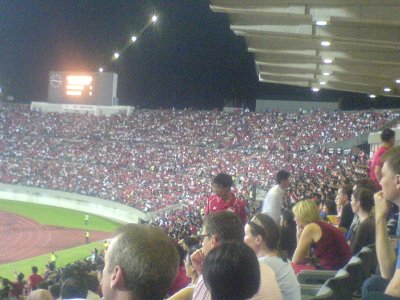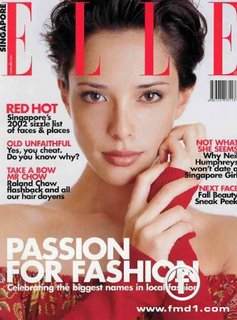
Seriously, was last night’s Singapore-Thailand face off resulting in a 2-1 win for the Lions a game to debate about for weeks or what? Check these pictures out.
Nevermind the fact that a Thai player was stretchered off the pitch barely two minutes into the game, nevermind Singapore capitalised on the opportunity for an early goal in the 17th minute, nevermind that stretchers continued to appear on the pitch for every few minutes throughout the entire evening, nevermind even that Thailand came back with a good looking goal right after half-time.
 Moments before Singapore scored the first goal
Moments before Singapore scored the first goalWhat was the most interesting was the Thai team walking off the pitch at the 83rd minute in disagreement with the referee’s decision to award Singapore a penalty kick a mere few metres away from the goal.



Oh.my.goodness. As far as I’ve heard, no team has done that in Singapore before, nor England for that matter (can someone confirm this?), and the Singaporean fans were in absolute shock.
Throughout the tense 15 minute stand-off, when match officials in suits approached the referee and the Thai side, all the fans could see were gesticulating and the Thai team huddled together in heated discussion. Meanwhile, fans shouted a variety of “Booooo”, “Loser” and sang “Oleh Oleh Oleh”, seeming extremely entertained by the turn of events.
Here’s the
report.
I mean, talk about drama!
When the situation cooled off, Singapore then went on to convert the penalty kick into a brilliant goal so that was the icing on the cake. I say cake because the penalty was arguably a harsh decision by the ref, and I’ll bet he didn’t sleep very well last night.
I’m now really worried for the Lions because this fiasco has undoubtedly further strained relations between our countries, in light of the political issues involving Temasek and Shin Corp, so Singaporeans should take care for the second leg of the match.
I had the privilege of interview Aviva’s regional brand and communications director Jessica Lee earlier in the day and as Jessica’s a veteran in dealing with sports sponsorships, I asked her how do sponsors cope in situations where an event goes bad or when an athlete breaks the rules.
Without giving too much away (you’d have to read
Marketing’s March edition for the interview), she said sponsors enter such deals with their eyes wide open and are prepared to distance themselves from specific athletes should they do something disgraceful. Clauses protecting the sponsor, specifying what will happen in the event of negative situations are laid out from the start.
Cheers to World Sport Group which kindly offered me complimentary grandstand tickets to the match through Edelman after reading my blog on the Saturday game. It was an awesome experience, I’m a soccer convert!!







